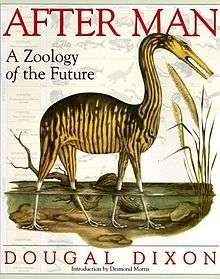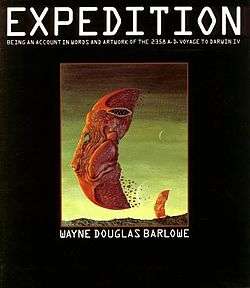Speculative evolution

Speculative evolution, also called speculative biology and speculative zoology, is a genre of speculative fiction and an artistic movement, focused on hypothetical scenarios in the evolution of life. Works incorporating speculative evolution may have entirely conceptual species that evolve on a planet other than Earth, or they may be an alternate history focused on an alternate evolution of terrestrial life. With a strong connection to and basis in science, particularly biology, speculative evolution is often considered hard science fiction. Speculative biology and creature concepts are also a prevalent subject in concept art.
Basis in biology and paleontology
With the main topic of speculative evolution being evolutionary biology, it shares with many science fiction subgenres a focus on scientific plausibility.
Although vertebrate paleontologist Darren Naish concedes that speculative evolution is full of "possibilities, crazy ideas, speculations, and things you wish you knew but never will", he suggests that "some of our speculations about animal evolution involve possibly useful and informative guesses and hypotheses... and some of these speculations are designed with real-world adaptations, processes and diversity in mind."[1]
Speculative evolution, with its relation to hard science fiction, builds on our knowledge of the real world and uses evolutionary principles to possibly develop a genuine hypothesis about the future. In some cases, speculative evolution artists have conceived of the existence of a creature before it was discovered by paleontologists. An imaginary filter-feeding 'Ceticaris', conceived by artist John Meszaros, was published in All Yesterdays before the discovery of the first filter-feeding anomalocarid, Tamisiocaris—which was subsequently included in the clade Cetiocaridae.[2] In addition, some of Dougal Dixon's speculative dinosaurs have predicted the paleobiologies of actual dinosaurs.[3]
The books All Yesterdays (2012) and All Your Yesterdays (2013) presented hypothetical forms of existing prehistoric creatures, applying speculative principles to paleoart in a manner similar to speculative zoologist Dixon.[4]
Speculative evolution is often connected to the scientific fields of astrobiology and xenobiology. Speculative biology writings focusing on extraterrestrial life, like the blog Furahan Biology, use realistic scientific principles to describe the biomechanics of hypothetical alien life.[5] However, speculative biology is not the same as xenobiology—it is a larger, distinct concept, which includes the alternate evolution of life in any scenario, terrestrial or extraterrestrial.[6]
History

German zoologist Gerolf Steiner described a fictitious order of mammals, Rhinogradentia, in the book Bau und Leben der Rhinogradentia (1957). Translated into English as The Snouters: The Form and Life of the Rhinogrades, it described the evolution, biology, and behavior of the fictional rhinogrades.[7][8]
One person who is regarded as the founder of the modern speculative evolution movement is geologist Dougal Dixon, the author of After Man (1981), The New Dinosaurs (1988), and Man After Man (1990).[2][9][10] According to Dixon, whose works have heavily influenced later speculative evolution works, his original inspiration was The Time Machine (1895) by H.G. Wells. Wells envisions giant crab-like creatures inhabiting a dying future Earth.[2] In Omni magazine (11|1982) the article “Visions of Man Evolved” by Pamela Weintraub is published, where Dougal Dixon describes his vision of the future evolution of mankind and animals surviving near people. Some ideas look very doubtful, like hybrids of scavenging animals and genetically modified and discarded human organs, or ground-creeping birds. Also large-brained human being with reduced body looks too improbable as a possible direction of evolution.
Expedition (1990) by Wayne Barlowe explored the evolution of the fictional planet Darwin IV, one of the first books to do so for a speculative world other than Earth. The Ringworld series by Larry Niven also details the divergent evolution of a series of hominids from a common ancestor across the immense and varied terrain of the series' eponymous Ringworld.
Peter Ward in his Future Evolution (2001) tries to make a scientifically accurate approach to the prediction of directions and patterns of evolution in the future. He tries to understand the mechanism of mass extinctions and the principles of recovery of ecosystems. Also he describes the features of possible best survivors in mass extinctions and the main features of the human-induced extinctions. In his book Time Traveller moves to the future and sees first the climate changing, and then the world of wast dumps inhabited by descendants of rats, pigs and other smaller vertebrates. And top predators of this world were birds, possible descendants of crows.
The World of Kong: A Natural History of Skull Island (2005) explored the world of King Kong (2005) from a biological perspective, envisioning Skull Island as a surviving fragment of ancient Gondwana. Prehistoric creatures on a declining, eroding island evolved into "a menagerie of nightmares",[11] a notable example of horror-themed speculative biology. The designers of the rebooted King Kong universe were inspired by Dougal Dixon's works.[12]
The Cryptozoologicon Volume I (2013) was a tongue-in-cheek combination of speculative biology and cryptozoology, using scientific scrutiny to analyze fictional creatures. It explored new directions on how to depict ancient animals with a particularly speculative nature.[13][14]
Use of the concept in other genres
Speculative evolution ideas are often used in science fiction works that do not strictly belong to the genre. The creatures in the 2005 film King Kong were fictitious descendants of real animals, with Skull Island being inhabited by dinosaurs and other prehistoric fauna.[11] Inspired by Dougal Dixon's works, the designers imagined what 65 million years or more of isolated evolution might have done to dinosaurs.[12]
In the novel Evolution by Stephen Baxter, some chapters are dedicated to the description of futuristic animals, including the posthumans. In various chapters of the book we see elements of speculative evolution. These are intelligent Ornitholestes dinosaurs, Cenozoic dinosaurs and other primitive inhabitants of Antarctica, futuristic descendants of pigs, goats, rats, rabbits and humans, and symbiosis between barometz tree and posthumans of New Pangea 500 MY in the future.
Cloverfield (2008) centered around a giant semiaquatic monster, Clover. The central monster was designed with its habitat (the deep ocean) in mind, and its traits, except for its size, were inspired by biological plausibility.[15]
The 2009 film Avatar constructed a fictional biosphere full of original, speculative alien species. James Cameron hired a team of experts to ensure that the lifeforms were scientifically plausible.[16][17] The creatures of the movie took inspiration from Earth species as diverse as pterosaurs, microraptors, great white sharks, and panthers, and combined their traits to create an alien world.[18]
Speculative biology and the future evolution of the human species has also become a significant issue in bio art.[19]
Examples
Books and graphic novels
- Dougal Dixon
- After Man: A Zoology of the Future (1981)
- The New Dinosaurs: An Alternative Evolution (1988)
- Man After Man: An Anthropology of the Future (1990)
- The Future Is Wild (2003) - with John Adams
- Greenworld (2010)
- Peter Ward,
- Future Evolution (2001)
- The Life and Death of Planet Earth (2004)
- C.M. Kosemen,
- All Tomorrows (2008)
- Cryptozoologicon Volume I (2013) with Darren Naish, John Conway
- Olaf Stapledon, Last and First Men: A Story of the Near and Far Future (1930)
- Gerolf Steiner, Bau und Leben der Rhinogradentia (1957)
- Robert Forward, Dragon's Egg (1980)
- Kurt Vonnegut, Galápagos (1985)
- Wayne Barlowe, Expedition (1990)
- Stephen Baxter, Evolution (2002)
- Weta Workshop, Peter Jackson, The World of Kong: A Natural History of Skull Island (2005)
- Marc Boulay, Jean-Sébastien Steyer, Demain, Les Animaux du Futur (2015)
Mock documentaries
- The Future is Wild (2002)
- The Last Dragon (2004)
- Alien Planet (2005)
Websites
- C.M. Kosemen, Life on Snaiad
- Gert van Dijk, Furahan Biology and Allied Matters
- Mex, The Ambarra project (Russian language)
- P. Volkov, The Neocene project (Russian project with some pages translated into English)
See also
References
- ↑ Naish, Darren. "Speculative Zoology at Tet Zoo, The Story So Far". Retrieved 2015-06-04.
- 1 2 3 Naish, Darren. "Of After Man, The New Dinosaurs and Greenworld: an interview with Dougal Dixon". Retrieved 2015-06-04.
- ↑ ""Alternative Evolution" of Dinosaurs Foresaw Contemporary Paleo Finds [Slide Show]". Retrieved 2015-06-08.
- ↑ "Science Meets Speculation in All Your Yesterdays – Phenomena: Laelaps". Retrieved 2015-06-08.
- ↑ Newitz, Annalee. "An intensive, multi-year study of realistic alien life". Retrieved 2015-06-08.
- ↑ Nastrazzurro, Sigmund. "Furahan Biology and Allied Matters: An xenobiological conference call". Furahan Biology and Allied Matters. Retrieved 2015-06-08.
- ↑ Nastrazzurro, Sigmund. "Furahan Biology and Allied Matters: Rhinogradentia I". Furahan Biology and Allied Matters. Retrieved 2015-06-04.
- ↑ "At last, the rhinogradentians (part I)". Retrieved 2015-06-04.
- ↑ Lamar, Cyriaque. "The horrors of evolution: the 10 freakiest animals of speculative biology". Retrieved 2015-06-04.
- ↑ Nastrazzurro, Sigmund. "Furahan Biology and Allied Matters: An unknown speculative biology project by Dougal Dixon: Microplatia I". Furahan Biology and Allied Matters. Retrieved 2015-06-08.
- 1 2 Jackson, Peter; Workshop, Weta (2005). The World of Kong: A Natural History of Skull Island. Simon and Schuster. ISBN 9781416505198.
- 1 2 Recreating the Eighth Wonder: The Making of King Kong (DVD). Universal. 2006.
- ↑ Newitz, Annalee. "Cryptozoologicon Could Revolutionize the Field of Monster Studies". Retrieved 2015-06-04.
- ↑ Naish, Darren. "The Cryptozoologicon (Volume I): here, at last". Retrieved 2015-06-04.
- ↑ Kelly, Kevin. "io9 Talks To Cloverfield Monster Designer Neville Page". Retrieved 2015-06-05.
- ↑ Kozlowski, Lori. "Inventing the plants of 'Avatar'". Los Angeles Times. ISSN 0458-3035. Retrieved 2015-06-04.
- ↑ Yoon, Carol Kaesuk (2010-01-18). "A Vibrant Fantasy World Has Science at Its Core". The New York Times. ISSN 0362-4331. Retrieved 2015-06-04.
- ↑ "The Tet Zoo guide to the creatures of Avatar". Retrieved 2015-06-05.
- ↑ "Speculative Biology in the practices of BioArt". Retrieved 2015-06-08.
External links
- Is this a portrait of a human 50 million years from now? - Kotaku
- Welcome to Snaiad, The World We Will Colonize - io9
- Life on Snaiad
- Silicon-based life
- Furahan Biology
- Future Zoology
- The Ambarra project
- The Neocene project (English version), list of parts in Russian
- Project Nereus - alien world.